| |
 |
WAXWINGS Bombycillidae |
- 3 species in northern Hemisphere
- DR personal total: 2 species (67%), 2 photo'd
|
 The Waxwings are a small family of Northern Hemisphere passerines, known for their irruptive flocks, soft crests, and waxy spots on their wings. There are just three species in the family: the two illustrated with photos here and Japanese Waxwing Bombycilla japonica of northeast Asia. Only Cedar Waxwing and Bohemian Waxwing have the odd, drop-like, waxy appendages on the tips of their secondaries. Japanese Waxwing lacks this feature but does have red-pigmented tips to the feathers themselves. The purpose of the waxy spots is not known, and is not apparently linked to sex or age (except it is lacking in streaky juvenal plumage; Mountjoy 2005). The Waxwings are a small family of Northern Hemisphere passerines, known for their irruptive flocks, soft crests, and waxy spots on their wings. There are just three species in the family: the two illustrated with photos here and Japanese Waxwing Bombycilla japonica of northeast Asia. Only Cedar Waxwing and Bohemian Waxwing have the odd, drop-like, waxy appendages on the tips of their secondaries. Japanese Waxwing lacks this feature but does have red-pigmented tips to the feathers themselves. The purpose of the waxy spots is not known, and is not apparently linked to sex or age (except it is lacking in streaky juvenal plumage; Mountjoy 2005).
Widespread in temperate North America is Cedar Waxwing, visiting a pyrrocantha bush. Waxwings and berry bushes are closely linked; flocks gather to devour one crop and then, almost mysteriously, disappear to find the next.
Farther north, and spread across the entire Holarctic, is the larger Bohemian Waxwing (below in a exquisite photo by Graham Catley). I always think of Bohemian Waxwings as birds of ice and frost, and Graham's photo (taken in England on a cold wintry day in February) captures this feeling — ice clinging to the bare twigs, contrasting with the soft gray textures of the bird. His shot also shows well the odd wax-like droplets on the wings for which the birds are named. |
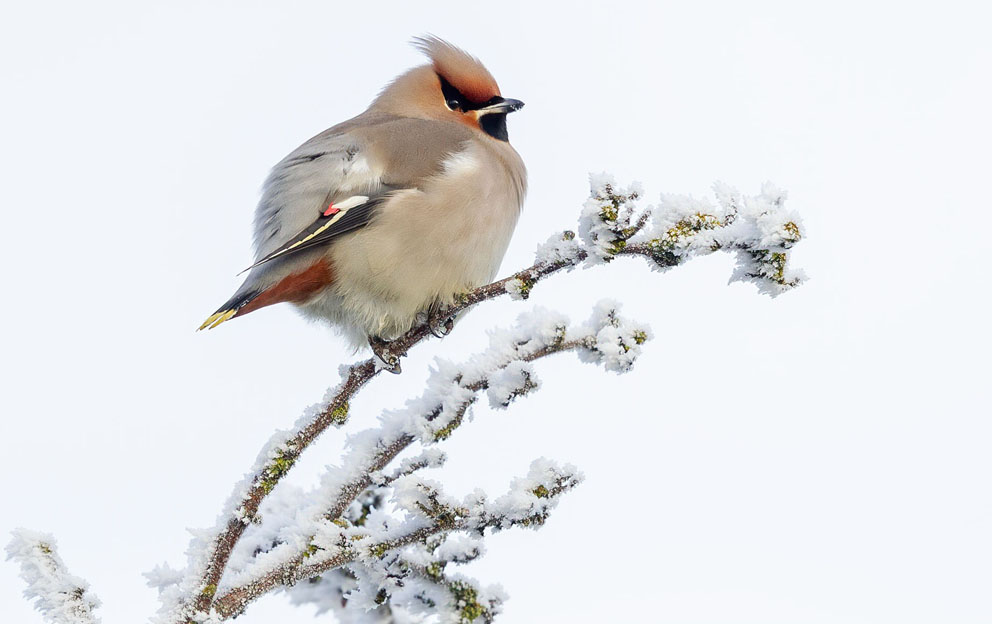 |
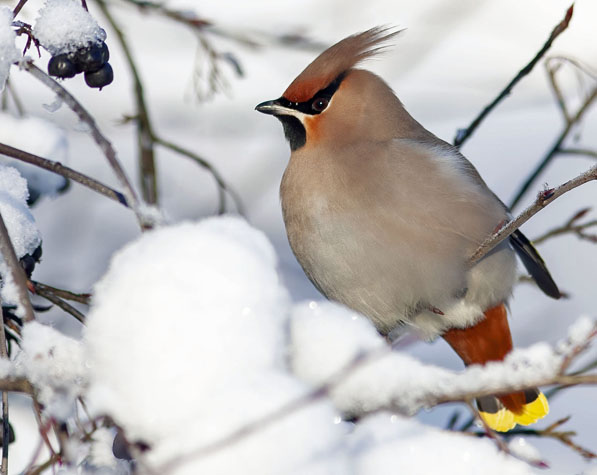 I rather like how Bent (1950) introduced the Bohemian Waxwing, even if words like "gay" no longer are used this same way: I rather like how Bent (1950) introduced the Bohemian Waxwing, even if words like "gay" no longer are used this same way:
"The Bohemian waxwing is an elegant bird, a well-dressed gentleman in feathers, a Beau Brummel among birds. He is not so gaudily dressed in gay colors as many other birds are, but his sleek and silky plumage, in softly blended harmonious shades of modest grays and browns, clothes his shapely form in a most pleasing combination of colors... He is a gentleman in appearance and a courteous gentleman in behavior, as all who have seen him in association with his fellows, or with other species will attest... To most of us, these Bohemians are birds of mystery; we never know when or where we may see these roving bands of gypsies. They come and they go, we know not whence or whither, in the never-ending search for a bounteous food supply on which to gorge themselves."
Graham Catley captured this elegant Bohemian Waxwing, with its striking undertail coverts, in the snowy winter landscape in Finland, of which he writes that "it was a balmy -25°C when he took this shot [that's -13°F ... brrrr]. |
In summer, waxwings are birds of wooded country, often preferring the edges. Bohemian Waxwing (far right) is a bird of boreal forest and muskegs in high northern latitudes circumpolar. Cedar Waxwing (near right) breeds widely in southern Canada and northern United States in deciduous, coniferous, and riparian woodlands. In winter, both species move south in flocks, following berry crops. They'll stay while a good crop is present and move elsewhere after it is depleted, typically reaching their southernmost point in February (Mountjoy 2005). Both species tend to perch high in the canopy, or even at the very top of tall trees.
Another neat feature about waxwings is their very high-pitched calls, picked out by the keen-eared birder. The calls of Bohemians are lower-pitched and rougher; the really challenge to beginning American birders is learning to "filter the air" with one's ears to tune in flocks of Cedar Waxwings. For some older observers, this is one of the first sounds to be lost as hearing deteriorates. |
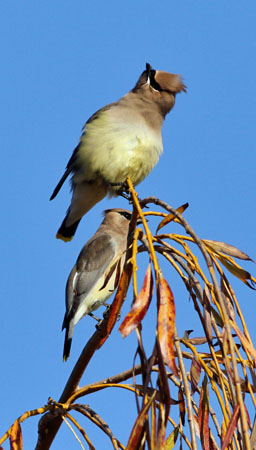 |
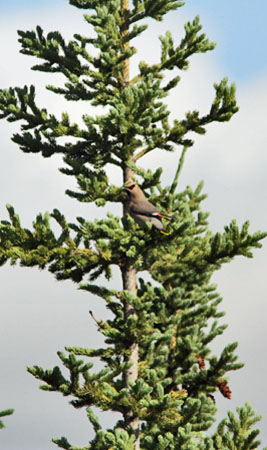 |
|
The Bombycillidae are well known for their winter incursions. Japanese Waxwing breeds in eastern Russia but goes south in winter to Japan, Korea, and northeast China. Much more is known about the incursions of more widespread species. Among the longest flights documented are a Bohemian Waxwing, banded in summer in Poland, that recovered in winter in Siberia, 5500 km distant (~3400 miles; Mountjoy 2005). Two Cedar Waxwings banded one year in southern California, were recovered in subsequent winters in Alabama, 3100 km distant (over 1900 miles; Mountjoy 2005), not to mention where they might have gone to breed!
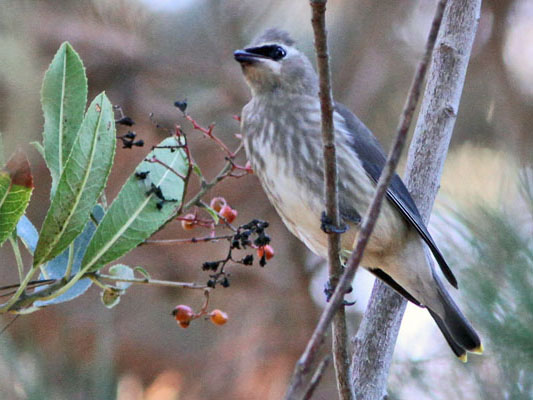 For those of us who live south of the usual breeding range of any waxwing species, gregarious flocks of waxwings are one of the first signs that summer is over. In Monterey County, the first Cedars arrive by mid-September and then linger quite late. Their abundance appears to increase in April-May (with the fruiting of more trees and bushes?) and a few often linger to the first of June. We were unable to be sure whether any of them nest in Monterey County during our Breeding Bird Atlas (Roberson & Tenney 1983), although there was some fairly compelling circumstantial evidence. They probably nest here occasionally. However, the presence of juvenal-plumaged waxwings is not an indication of breeding by late summer, as flocks — many with hatch-year birds — start appearing in localities that are significantly south of their breeding range by August. Such juvenal-plumaged birds are dull and gray, without waxy wing-spots, and have blurry streaks below, as this one (right). For those of us who live south of the usual breeding range of any waxwing species, gregarious flocks of waxwings are one of the first signs that summer is over. In Monterey County, the first Cedars arrive by mid-September and then linger quite late. Their abundance appears to increase in April-May (with the fruiting of more trees and bushes?) and a few often linger to the first of June. We were unable to be sure whether any of them nest in Monterey County during our Breeding Bird Atlas (Roberson & Tenney 1983), although there was some fairly compelling circumstantial evidence. They probably nest here occasionally. However, the presence of juvenal-plumaged waxwings is not an indication of breeding by late summer, as flocks — many with hatch-year birds — start appearing in localities that are significantly south of their breeding range by August. Such juvenal-plumaged birds are dull and gray, without waxy wing-spots, and have blurry streaks below, as this one (right).
|
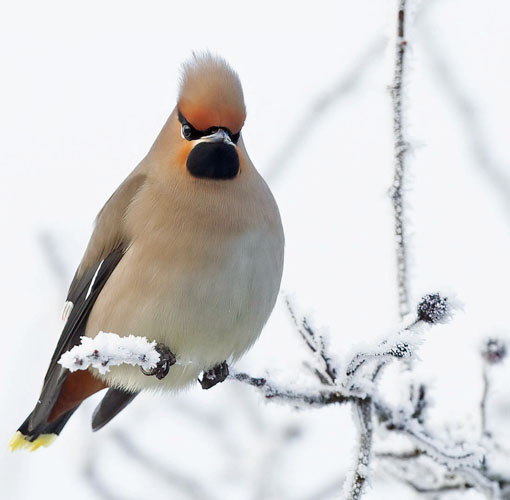 Members of the Bombycillidae are distinctive birds. A Bohemian Waxwing (left, in another cold-winter shot by Graham Catley) is recognized by its size, its silky crest, its chestnut undertail coverts, and its yellow tail-tip. Japanese Waxwing also has a crest and chestnut undertail coverts but its tail-tip band is red; it is mid-sized. Cedar Waxwing is the smallest waxwing. It has a crest, whitish undertail coverts, and a yellow tip to tail. Members of the Bombycillidae are distinctive birds. A Bohemian Waxwing (left, in another cold-winter shot by Graham Catley) is recognized by its size, its silky crest, its chestnut undertail coverts, and its yellow tail-tip. Japanese Waxwing also has a crest and chestnut undertail coverts but its tail-tip band is red; it is mid-sized. Cedar Waxwing is the smallest waxwing. It has a crest, whitish undertail coverts, and a yellow tip to tail.
While identification is straight-forward, the taxonomic relationships of the Bombycillidae remain controversial. Sibley & Monroe (1990) placed the family in close proximity to thrushes and Old World flycatchers, and listed three "tribes" of the Bombycillidae: the waxwings (Bombycillini), the Palmchat (Dulini), and the silky-flycatchers (Ptilogonatini). All these "tribes" are now elevated to Family level, but closely related to Bombycillidae. All agree that they are likely each other's closest relatives, and they are similar to each other in skeletal characters. So is the Hypocolius of the Middle East (now Hypocoliidae) and Hylocitrea of Sulawesi (now Hylocitreidae). But, in the big picture, where this enigmatic set of birds should be placed remains less than certain. In the Handbook of the Birds of the World series, waxwings were placed somewhere between Bulbuls and Wrens (Mountjoy 2005), but that placement in now out of favor. As of 2021, the South American Checklist Committee stated: "Some genetic data (Voelker & Spellman 2004) suggest that the Bombycillidae are not closely related to the Muscicapoidea assemblage, as proposed by Sibley & Ahlquist (1990); other genetic data (Barker et al. 2004) support that relationship. Jonsson & Fjeldså (2006) included them within the Muscicapoidea, but Johansson et al. (2008) found little support for that placement." Most world checklists continue to place it near the Old World Flycatcher (Muscicapidae) and before the Flowerpeckers and Sunbirds, thus more or less what Sibley & Monroe (1990) had proposed. |
| |
Photos: The two berry-eating Cedar Waxwing Bombycilla cedrorum were photographed 27 Dec 2019 (top) and 9 Jan 2021 (upper left), in Monterey County, California, USA. Graham Catley graciously provided all the close-up photos of Bohemian Waxwing Bombycilla garrulus. His first and third shots were taken in Lincolnshire, England, on 23 Jan 2013; his second portrait was from Finland on 6 Feb 2007. The Cedar Waxwing atop a bush was at Monterey, CA, on 3 Dec 2015, and the juvenile was at Pacific Grove, CA, on 31 Oct 2015. The summer Bohemian Waxwing in a distant fir was along the Denali Highway, Alaska, on 6 July 2011.
Uncredited photos © Don Roberson. Credited photos © Graham Catley, as credited, and used with permission; all rights reserved. Graham Catley photographs birds at the professional level. He has an excellent web site featuring Britain and European birds, especially British rarities.
Bibliographic note: There is no "family book" per se, but a fine introduction to this family, with some dazzling photos, is in Mountjoy (2005).
Literature cited:
Barker, F.K., A. Cibois, P. Schikler, J. Feinstein, and J. Cracraft. 2004. Phylogeny and diversification of the largest avian radiation. Proc. Nat.l Acad. Sci. 101: 11040–11045.
Bent, A. C. 1950. Life histories of North American wagtails, shrikes, vireos, and their allies. U. S. Nat. Mus. Bull. 197. Smithsonian Instit., Washington, D. C.
Johansson, U.S., J. Fjeldså, and R.C.K. Bowie. 2008. Phylogenetic relationships within Passerida (Aves: Passeriformes): a review and a new molecular phylogeny based on three nuclear intron markers. Molec. Phylog. Evol. 48: 858–876.
Jonsson, K.A., and J. Fjeldså. 2006. A phylogenetic supertree of oscine passerine birds (Aves: Passeri). Zoologica Scripta 35: 149–186.
Mountjoy, D.J. 2005. Family Bombycillidae (Waxwings), pp. 304–318 in Handbook of the Birds of the World (del Hoyo, J., A. Elliott &D.A. Christie, eds). Vol. 10. Lynx Edicions, Barcelona, Spain..
Roberson, D., and C. Tenney, eds. Atlas of the Breeding Birds of Monterey County, California. Monterey Audubon Soc., Carmel.
Sibley, C. G., and B. L. Monroe, Jr. 1990. Distribution and Taxonomy of Birds of the World. Yale Univ. Press, New Haven, CT.
Voelker, G., and G.M. Spellman. 2004. Nuclear and mitochondrial DNA evidence of polyphyly in the avian superfamily Muscicapoidea. Molec. Phylog. Evol. 30: 386-394.
|
|
|



 The Waxwings are a small family of Northern Hemisphere passerines, known for their irruptive flocks, soft crests, and waxy spots on their wings. There are just three species in the family: the two illustrated with photos here and Japanese Waxwing Bombycilla japonica of northeast Asia. Only Cedar Waxwing and Bohemian Waxwing have the odd, drop-like, waxy appendages on the tips of their secondaries. Japanese Waxwing lacks this feature but does have red-pigmented tips to the feathers themselves. The purpose of the waxy spots is not known, and is not apparently linked to sex or age (except it is lacking in streaky juvenal plumage; Mountjoy 2005).
The Waxwings are a small family of Northern Hemisphere passerines, known for their irruptive flocks, soft crests, and waxy spots on their wings. There are just three species in the family: the two illustrated with photos here and Japanese Waxwing Bombycilla japonica of northeast Asia. Only Cedar Waxwing and Bohemian Waxwing have the odd, drop-like, waxy appendages on the tips of their secondaries. Japanese Waxwing lacks this feature but does have red-pigmented tips to the feathers themselves. The purpose of the waxy spots is not known, and is not apparently linked to sex or age (except it is lacking in streaky juvenal plumage; Mountjoy 2005).  I rather like how Bent (1950) introduced the Bohemian Waxwing, even if words like "gay" no longer are used this same way:
I rather like how Bent (1950) introduced the Bohemian Waxwing, even if words like "gay" no longer are used this same way: 

 For those of us who live south of the usual breeding range of any waxwing species, gregarious flocks of waxwings are one of the first signs that summer is over. In Monterey County, the first Cedars arrive by mid-September and then linger quite late. Their abundance appears to increase in April-May (with the fruiting of more trees and bushes?) and a few often linger to the first of June. We were unable to be sure whether any of them nest in Monterey County during our Breeding Bird Atlas (Roberson & Tenney 1983), although there was some fairly compelling circumstantial evidence. They probably nest here occasionally. However, the presence of juvenal-plumaged waxwings is not an indication of breeding by late summer, as flocks — many with hatch-year birds — start appearing in localities that are significantly south of their breeding range by August. Such juvenal-plumaged birds are dull and gray, without waxy wing-spots, and have blurry streaks below, as this one (right).
For those of us who live south of the usual breeding range of any waxwing species, gregarious flocks of waxwings are one of the first signs that summer is over. In Monterey County, the first Cedars arrive by mid-September and then linger quite late. Their abundance appears to increase in April-May (with the fruiting of more trees and bushes?) and a few often linger to the first of June. We were unable to be sure whether any of them nest in Monterey County during our Breeding Bird Atlas (Roberson & Tenney 1983), although there was some fairly compelling circumstantial evidence. They probably nest here occasionally. However, the presence of juvenal-plumaged waxwings is not an indication of breeding by late summer, as flocks — many with hatch-year birds — start appearing in localities that are significantly south of their breeding range by August. Such juvenal-plumaged birds are dull and gray, without waxy wing-spots, and have blurry streaks below, as this one (right). Members of the Bombycillidae are distinctive birds. A Bohemian Waxwing (left, in another cold-winter shot by Graham Catley) is recognized by its size, its silky crest, its chestnut undertail coverts, and its yellow tail-tip. Japanese Waxwing also has a crest and chestnut undertail coverts but its tail-tip band is red; it is mid-sized. Cedar Waxwing is the smallest waxwing. It has a crest, whitish undertail coverts, and a yellow tip to tail.
Members of the Bombycillidae are distinctive birds. A Bohemian Waxwing (left, in another cold-winter shot by Graham Catley) is recognized by its size, its silky crest, its chestnut undertail coverts, and its yellow tail-tip. Japanese Waxwing also has a crest and chestnut undertail coverts but its tail-tip band is red; it is mid-sized. Cedar Waxwing is the smallest waxwing. It has a crest, whitish undertail coverts, and a yellow tip to tail.